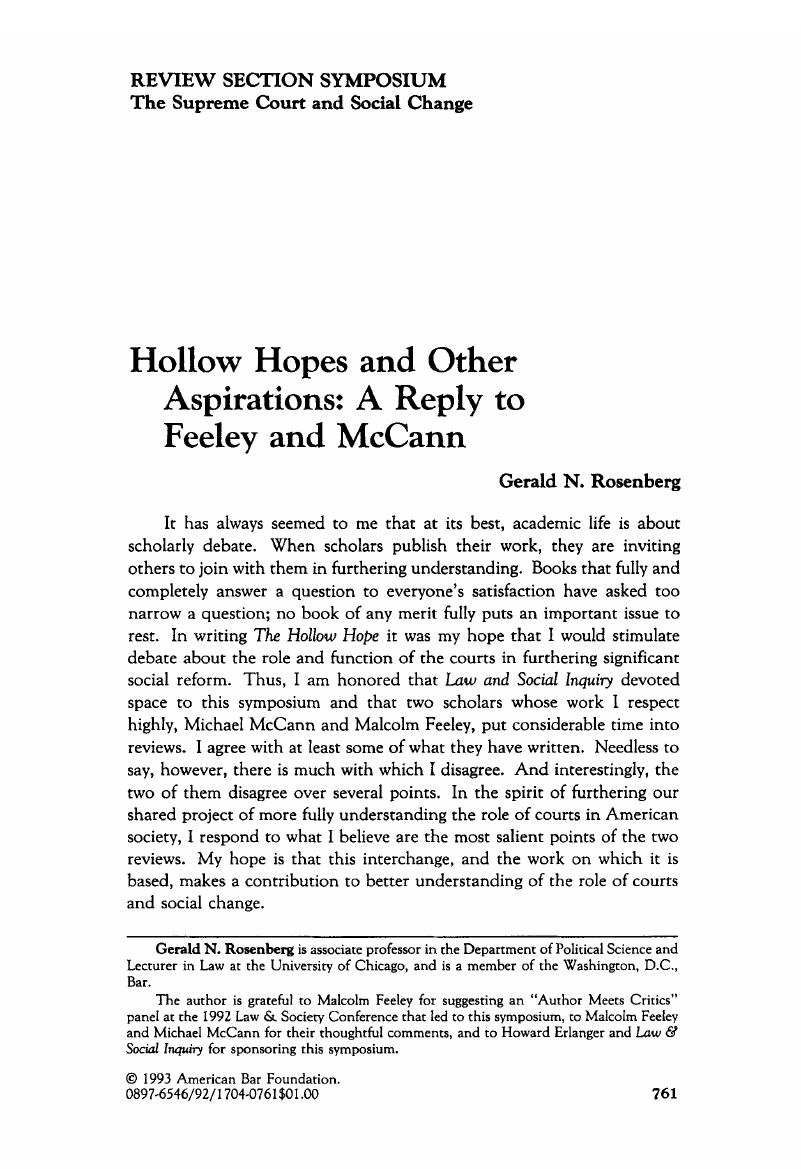Published online by Cambridge University Press: 27 December 2018

1 I am currently engaged in a project that looks at the prevalence of claims of rights in modern American politics. Part of the project will explore the questions Feeley raises.Google Scholar
2 I only wish that more of my law school professors had held my legal skills in as high regard as Feeley does!Google Scholar
3 Feeley, for example! See Becker, Theodore L. & Feeley, Malcolm M., eds., The Impact of Supreme Court Decisions (2d ed. Oxford: Oxford University Press, 1973).Google Scholar
4 See, e.g., the tribute to Marshall in 44 Stan. L Rev. 1209 (1992), particularly the article by Cass Sunstein at 1267.Google Scholar
5 See the relevant chapters of The Hollow Hope for data supporting this claim.Google Scholar
6 Chapter 4 of The Hollow Hope explores possible positive differences that Brown could have made, such as changing opinions, putting civil rights on the national agenda, mobilizing citizens, pressuring elected officials, and so forth. I find little evidence for these and other indirect effects claims.Google Scholar
7 For a detailed examination of this backing away, see Wasby, Stephen L., Anthony A. D'Amato, & Rosemary Metrailer, Desegregation from Brown to Alexander (Carbondale: Southern Illinois University Press, 1977).Google Scholar
8 See Rosenberg, Gerald N., “Judicial Independence and the Reality of Political Power,” 54 Rev. Politics 369 (1992).Google Scholar
9 The best study of this period is Murphy, Walter F., Congress and the Court (Chicago: University of Chicago Press, 1962). See also Rosenberg, 54 Rev. Politics.Google Scholar
10 See The Hollow Hope ch. 11, particularly at 324–29.Google Scholar
11 See The Hollow Hope 131–30, especially at 145 n.39.Google Scholar
12 Henry Hampton & Steve Fayer, eds., Voices of Freedom: An oral History of the Civil Rights Movement from the 1950s through the 1980s at xix (New York: Bantam Books, 1990). The reader should note that detailed studies of the Montgomery bus boycott do not give much, if any, credit to Brown. The relationship between the two events is discussed in some detail in The Hollow Hope 134–38.Google Scholar
13 August Meier & Elliott Rudwick, eds., CORE: A Study in the Civil Rights Movement 1942-1968, at 34 (New York: Oxford University Press, 1973).Google Scholar
14 Garrow, David J., Bearing the Cross: Martin Luther King, JT., and the Southern Christian Leadership Conference 85 (New York: William Morrow, 1986). See also at 86.Google Scholar
15 I note one such mention during the Montgomery bus boycott in The Hollow Hopeat 136 n.21.Google Scholar
16 The event is discussed briefly in The Hollow Hope 149 n.46.Google Scholar
17 The Hollow Hope 145–46.Google Scholar
18 The Hollow Hope 132.Google Scholar
19 Quoted in Dick Cluster, ed., They Should Have Sad That Cup of Coffee 25 (Boston: South End Press, 1979).Google Scholar
20 Id at 2.Google Scholar
21 The Hollow Hope 131–50, especially at 145 n.39.Google Scholar
22 On the logic of McCann's argument, this increase was in large part due to the Supreme Court's important decision in Smith v. All wright (321 U.S. 649 (1944)), essentially invalidating white-only primaries. Before reaching this conclusion, my concern for drawing inferences would lead me to examine changes in black income over the time period, the effect of mass black migration out of the rural South co urban areas, black soldiers returning home from World War II, the role of the federal government in maintaining racial peace during the war, and so forth. These factors are considered in chapter 5 of The Hollow Hope. Google Scholar
23 The Hollow Hope 151–52.Google Scholar
24 Eyes on the Prize, cited in The Hollow Hope at 152.Google Scholar
25 The Hollow Hope 152.Google Scholar
26 Doug McAdam, Political Process and the Development of Black Insurgency, 1930-1970at 3 (Chicago: University of Chicago Press, 1982) (“McAdam, Political Process”;).Google Scholar
27 Id Google Scholar
28 McCann, p. 724, quoting McAdam, Political Process 108.Google Scholar
29 McAdam, Political Process 108; emphasis added.Google Scholar
30 Note, too, my discussion of the muted black reaction to Brown. If Brown was received so quietly, does it seem plausible to think that other, less well-known cases made much of an impression?Google Scholar
31 The Hollow Hope 146–50.Google Scholar
32 McCann, p. 736, quoting Aldon Morris, The Origins of the Civil Rights Movement 34 (New York: Free Press, 1984) (“Morris, Origins”;).Google Scholar
33 Morris, Origins 32.Google Scholar
34 Id. at 37.Google Scholar
35 For discussion of the middle-class, conservative nature of the NAACP, see The Hollow Hope 147. For discussion of the founding of SNCC, CORE, and the SCLC, see idat 142–44. I do not mean to belittle the important role played by the NAACP over they ears and during the 1950s and 1960s. By providing legal defense for civil rights activists, the NAACP lent crucial support in keeping the movement alive. By establishing good contacts with federal officials, the NAACP helped keep the lines of communication open. And given its established record of “responsible” behavior, the NAACP (and the Urban League)could use the actions of the more activist groups to entice recalcitrant government and corporate officials to deal with them. On the symbiotic relation between direct action and mainstream civil rights groups, see Haines, Herbert H., Black Radicals and the Civil Rights Mainstream, 1954-1970 (Knoxville: University of Tennessee Press, 1988).Google Scholar
36 The data are presented and discussed in The Hollow Hope 133–35.Google Scholar
37 McCann, p. 737, quoting Morris, Origins 26.Google Scholar
38 Morris, Origins 81, noted by McCann in note 46.Google Scholar
39 For an attempt to further refine the concept, see Rosenberg, 54 Rev. Politics. Google Scholar
40 See, e.g., Luker, Kristin, Abortion and the Politics of Motherhood (Berkeley: University of California Press, 1984).Google Scholar
41 The Hollow Hope 340–41.Google Scholar
42 The Hollow Hope 339–40.Google Scholar
43 Mc, Michael W.Cann, Rights at Work: Law and the Politics of Pay Equity (Chicago: University of Chicago Press, forthcoming).Google Scholar
44 See ch. 4.Google Scholar